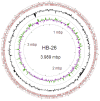Draft genome sequence of Bacillus amyloliquefaciens HB-26
- PMID: 25197462
- PMCID: PMC4149015
- DOI: 10.4056/sigs.4978673
Draft genome sequence of Bacillus amyloliquefaciens HB-26
Abstract
Bacillus amyloliquefaciens HB-26, a Gram-positive bacterium was isolated from soil in China. SDS-PAGE analysis showed this strain secreted six major protein bands of 65, 60, 55, 34, 25 and 20 kDa. A bioassay of this strain reveals that it shows specific activity against P. brassicae and nematode. Here we describe the features of this organism, together with the draft genome sequence and annotation. The 3,989,358 bp long genome (39 contigs) contains 4,001 protein-coding genes and 80 RNA genes.
Keywords: Bacillus amyloliquefaciens HB-26; Plasmodiophora brassicae; The Next-Generation sequencing.
Figures



Similar articles
-
High-quality draft genome sequence of nematocidal Bacillus thuringiensis Sbt003.Stand Genomic Sci. 2014 Mar 1;9(3):624-31. doi: 10.4056/sigs.4738557. eCollection 2014 Jun 15. Stand Genomic Sci. 2014. PMID: 25197449 Free PMC article.
-
High-quality draft genome sequence of the Thermus amyloliquefaciens type strain YIM 77409(T) with an incomplete denitrification pathway.Stand Genomic Sci. 2016 Feb 27;11:20. doi: 10.1186/s40793-016-0140-3. eCollection 2016. Stand Genomic Sci. 2016. PMID: 26925197 Free PMC article.
-
Draft genome sequence of Bacillus amyloliquefaciens subsp. plantarum strain Fito_F321, an endophyte microorganism from Vitis vinifera with biocontrol potential.Stand Genomic Sci. 2018 Nov 1;13:30. doi: 10.1186/s40793-018-0327-x. eCollection 2018. Stand Genomic Sci. 2018. PMID: 30410642 Free PMC article.
-
Draft Genome Sequence of Plant Growth-Promoting Bacillus amyloliquefaciens Strain W2 Associated with Crocus sativus (Saffron).Genome Announc. 2014 Sep 11;2(5):e00862-14. doi: 10.1128/genomeA.00862-14. Genome Announc. 2014. PMID: 25212614 Free PMC article.
-
High-Quality Draft Genome Sequence of Bacillus amyloliquefaciens Strain 629, an Endophyte from Theobroma cacao.Genome Announc. 2015 Nov 19;3(6):e01325-15. doi: 10.1128/genomeA.01325-15. Genome Announc. 2015. PMID: 26586881 Free PMC article.
Cited by
-
Identification and characterization of putative effectors from Plasmodiophora brassicae that suppress or induce cell death in Nicotiana benthamiana.Front Plant Sci. 2022 Sep 20;13:881992. doi: 10.3389/fpls.2022.881992. eCollection 2022. Front Plant Sci. 2022. PMID: 36204052 Free PMC article.
-
Tolerance Induction of Temperature and Starvation with Tricalcium Phosphate on Preservation and Sporulation in Bacillus amyloliquefaciens Detected by Flow Cytometry.Curr Microbiol. 2016 Sep;73(3):366-373. doi: 10.1007/s00284-016-1066-0. Epub 2016 Jun 1. Curr Microbiol. 2016. PMID: 27251036
-
A Review on the Biotechnological Applications of the Operational Group Bacillus amyloliquefaciens.Microorganisms. 2021 Mar 17;9(3):614. doi: 10.3390/microorganisms9030614. Microorganisms. 2021. PMID: 33802666 Free PMC article. Review.
References
-
- Chowdhury SP, Dietel K, Rändler M, Schmid M, Junge H, Borriss R, Hartmann A, Grosch R. Effects of Bacillus amyloliquefaciens FZB42 on Lettuce Growth and Health under Pathogen Pressure and Its Impact on the Rhizosphere Bacterial Community. PLoS ONE 2013; 8:e68818 10.1371/journal.pone.0068818 - DOI - PMC - PubMed
LinkOut - more resources
Full Text Sources
Other Literature Sources
Molecular Biology Databases

